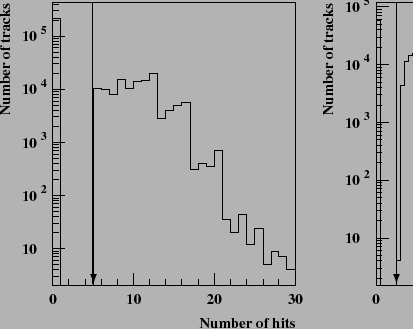Next: Armenteros-Podolanski Plot Up: Selection Previous: Event Selection Contents
To provide a fast background rejection the following cuts are used:
 |
These three cuts can be understood as a soft preselection in order to reduce the amount of data to be further processed.
The main cuts for extraction of ![]() signals are DCA, impact parameter
and flight path cuts. In order to optimize these cuts studies on MC and
data are performed. Efficiencies
versus applied cut distributions are shown in Fig. 6.3 for
signals are DCA, impact parameter
and flight path cuts. In order to optimize these cuts studies on MC and
data are performed. Efficiencies
versus applied cut distributions are shown in Fig. 6.3 for ![]() .
The plots at the top show the behavior of
signal and background versus the applied cut. Signals are taken from generated MC
and the background is obtained from data. The lower plots show the significances
(
.
The plots at the top show the behavior of
signal and background versus the applied cut. Signals are taken from generated MC
and the background is obtained from data. The lower plots show the significances
(
![]() ) for these cuts.
) for these cuts.
To cut on the flight path of the ![]() in the rest frame of the
in the rest frame of the ![]() candidate is the most efficient possibility to get rid of shortlived background,
coming from the target region.
candidate is the most efficient possibility to get rid of shortlived background,
coming from the target region.
A similar dependence of signal and background on the applied cuts was
observed for ![]() and
and
![]() , but as
, but as ![]() s are
longer lived particles compared to
s are
longer lived particles compared to ![]() (the flight path cut for
(the flight path cut for ![]() is 0.13 cm),
the cut for them was increased to 0.39 cm, this corresponds to
5
is 0.13 cm),
the cut for them was increased to 0.39 cm, this corresponds to
5![]() of the flight path of
of the flight path of ![]() s.
s.
All cuts are selected such that they are placed in the flat regions of the
efficiency curves. This allows us to be sure that if the ![]() MC signals behave not
exactly like in data, additional systematic uncertainties are small.
MC signals behave not
exactly like in data, additional systematic uncertainties are small.
Yury Gorbunov 2010-10-21